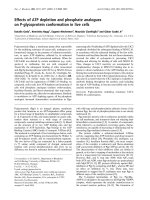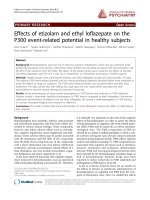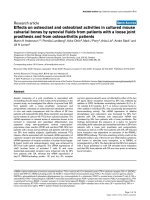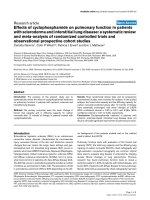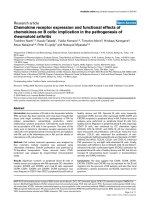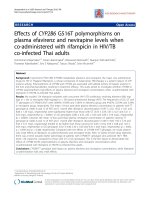Báo cáo y học: "Effects on management and outcome of severe sepsis and septic shock patients admitted to the intensive care unit after implementation of a sepsis program: a pilot study" docx
Bạn đang xem bản rút gọn của tài liệu. Xem và tải ngay bản đầy đủ của tài liệu tại đây (194.33 KB, 8 trang )
Open Access
Available online />Page 1 of 8
(page number not for citation purposes)
Vol 13 No 5
Research
Effects on management and outcome of severe sepsis and septic
shock patients admitted to the intensive care unit after
implementation of a sepsis program: a pilot study
Massimo Girardis
1
, Laura Rinaldi
1
, Lara Donno
1
, Marco Marietta
2
, Mauro Codeluppi
3
,
Patrizia Marchegiano
4
, Claudia Venturelli
5
and the 'Sopravvivere alla Sepsi 'group of the Modena-
University Hospital
1
Department of Anaesthesiology and Intensive Care, University of Modena and Reggio Emilia and University Hospital of Modena; L.go del Pozzo,
Modena, 41100, ITALY
2
Department of Haematology, University Hospital of Modena; L.go del Pozzo, Modena, 41100, ITALY
3
Department of Infectious Diseases, University Hospital of Modena; L.go del Pozzo, Modena, 41100, ITALY
4
Medical Direction, University Hospital of Modena; L.go del Pozzo, Modena, 41100, ITALY
5
Microbiology and Virology Unit, University Hospital of Modena; L.go del Pozzo, Modena, 41100, ITALY
Corresponding author: Massimo Girardis,
Received: 27 Sep 2008 Revisions requested: 25 Oct 2008 Revisions received: 23 May 2009 Accepted: 3 Sep 2009 Published: 3 Sep 2009
Critical Care 2009, 13:R143 (doi:10.1186/cc8029)
This article is online at: />© 2009 Girardis et al.; licensee BioMed Central Ltd.
This is an open access article distributed under the terms of the Creative Commons Attribution License ( />),
which permits unrestricted use, distribution, and reproduction in any medium, provided the original work is properly cited.
Abstract
Introduction The application in clinical practice of evidence-
based guidelines for the management of patients with severe
sepsis/septic shock is still poor in the emergency department,
while little data are available for patients admitted to the
intensive care unit (ICU). The aim of this study was to evaluate
the effect of an in-hospital sepsis program on the adherence to
evidence-based guidelines and outcome of patients with severe
sepsis/septic shock admitted to the ICU.
Methods This prospective observational cohort study included
67 patients with severe sepsis/septic shock admitted to a
multidisciplinary ICU at a University Hospital from January 2005
to June 2007. Compliance to 5 resuscitation and 4 management
sepsis interventions and in-hospital mortality were measured
following an educational program on sepsis for physician and
nurses of all hospital departments and hospital implementation
of a specific protocol for recognition and management of
patients with severe sepsis/septic shock, including an early
consultation by a skilled 'sepsis team'.
Results During the study period, the compliance to all 9
interventions increased from 8% to 35% of the patients (P <
0.01). The implementation of resuscitation and management
interventions was associated with a lower risk of in-hospital
mortality (23% vs 68% and 27% vs 68%, P < 0.01). In the latter
2 semesters, after activation of the 'sepsis team', in-hospital
mortality of ICU septic shock patients decreased by about 40%
compared with the previous period (32% vs 79%, P < 0.01).
Conclusions In our experience, an in-hospital sepsis program,
including education of health-care personnel and process-
changes, improved the adherence to guidelines and the survival
rate of patients with severe sepsis/septic shock admitted to the
ICU.
Introduction
The high incidence, costs and mortality rate of patients with
sepsis in the recent years has led the critical care scientific
community to develop specific strategies aimed to improve the
outcome of these patients [1-4]. In 2004, the Surviving Sepsis
Campaign (SSC) guidelines [3] recommended a series of
diagnostic and therapeutic interventions whose implementa-
tion was expected to lead to a survival benefit in patients with
severe sepsis/septic shock. Afterwards, to facilitate the appli-
cation of these guidelines in clinical practice, the Institute for
ALI: acute lung injury; ARDS: Adult respiratory distress syndrome; ED: emergency department; FiO
2
: fraction of inspired oxygen; ICU: intensive care
unit; IHI: institute for healthcare improvement; MAP: mean arterial pressure; OR: odds ratio; PaO
2
: partial pressure of arterial oxygen; rhAPC: recom-
binant human activated protein C; SAPS: simplified acute physiology score; ScvO
2
: central venous oxygen saturation; SOFA: simplified organ failure
assessment; SSC: Surviving Sepsis Campaign.
Critical Care Vol 13 No 5 Girardis et al.
Page 2 of 8
(page number not for citation purposes)
Healthcare Improvement (IHI) proposed the severe sepsis
resuscitation (6-hours) and management (24-hours) bundles,
that integrate the interventions described above. Neverthe-
less, the application of these bundles so far has been demon-
strated to be quite poor in most surveys, confirming the
difficulty of transferring evidence to the clinical practice [4-12].
The main purpose of our study was to evaluate the effects of a
'surviving sepsis' in-hospital project, including specific educa-
tional program and operative protocols, on the adherence to
evidence-based guidelines. Moreover, we sought to assess if
such a project could improve the outcome of patients with
severe sepsis/septic shock admitted to an intensive care unit
(ICU).
Materials and methods
Design, setting and population
This prospective observational study enrolled consecutive
patients with a diagnosis of severe sepsis/septic shock admit-
ted to an ICU of the 780-bed University Hospital of Modena
from January 2005 to June 2007. The study was approved by
the local ethical committee and the need for informed consent
was waived in view of the observational and anonymous nature
of the study. The ICU consists of nine beds and approximately
800 adult patients are admitted annually (70% surgical
patients). Staffing at any time consists of one attending physi-
cian, one resident physician and three to four nurses.
The inclusion criteria were: a) documented or suspected infec-
tion; b) two or more systemic inflammatory response syn-
drome criteria [13] and c) the onset of an organ dysfunction
related to infection: gas exchange impairment (partial pressure
of arterial oxygen (PaO
2
)/fraction of inspired oxygen (FiO
2
) <
250 mmHg), mean arterial pressure (MAP) below 65 mmHg,
acute renal dysfunction (1.5-fold baseline creatinine increase
or urine output < 0.5 ml/Kg/h for two hours), total bilirubin
above 4 mg/dL, platelet count below 80,000 cells/mm
3
(or a
100,000 cells/mm
3
decrease) or lactate blood concentration
above 4.0 mM. Patients with persistence of MAP below 65
mmHg after an adequate fluid infusion (see below) were clas-
sified as having septic shock. Patients with severe decompen-
sated chronic liver disease included in the waiting list for liver
transplantation were excluded from the study.
Data collection
Data collection began one month after the start of an in-hospi-
tal educational program on sepsis (see below) and only the
first episode of severe sepsis/septic shock was considered in
each patient. The management of patients was evaluated by
analysis of interventions and sepsis bundles [3]. We identified
five resuscitation (6-hours bundle) and four management (24-
hours bundle) interventions: blood cultures collection before
antibiotic administration; empiric antibiotic therapy within
three hours from diagnosis; control of infection source within
six hours; adequate fluid resuscitation before vasopressor
administration; central venous oxygen saturation (ScvO
2
)
above 70% within six hours; blood glucose median below 150
mg/dL in the first 24 hours; low-dose hydrocortisone adminis-
tration in association with vasopressor support; recombinant
human activated protein C (rhAPC) if administration indicated;
plateau inspiratory pressure below 30 cmH
2
O in patients with
acute lung injury (ALI)/adult respiratory distress syndrome
(ARDS). The term adequate fluid resuscitation indicates a cen-
tral venous pressure above 6 mmHg (above 8 mmHg if
mechanically ventilated) or a global end-diastolic volume by
trans-pulmonary thermodilution (PiCCO system, Pulsion, Ger-
many) above 700 ml/m
2
.
Two of the authors (LR and LD) not involved in the clinical
management of the patients, collected the above interventions
by analysis of clinical charts and any uncertain data was audit
with the attending physician. The interventions were classified
as completed and not completed. An intervention not applied
because not applicable (e.g. low plateau inspiratory pressure
in patient without ALI/ARDS) was defined as completed. The
time zero for bundles timing was the time in which the three
study inclusion criteria were documented by clinical notes.
Type of admission, grade of sepsis, primary site of infection,
simplified acute physiology score (SAPS) II and simplified
organ failure assessment (SOFA) score the day of sepsis
diagnosis [14,15], ICU and hospital length of stay, and hospi-
tal mortality were also recorded for each patient. Predicted
hospital mortality was calculated by SAPS II score.
Hospital program
The education phase of our hospital program named "Soprav-
vivere alla Sepsi nel Policlinico di Modena" (Surviving to Sep-
sis in Policlinico Hospital of Modena) started on November
2004 and continued throughout the study period. It included
basic, advanced and refresh courses with conference lectures
and practice training for nurses and physicians of all hospital
departments. From November 2004 to June 2007 almost 250
physicians (out of 400) and 300 nurses (out of 950) of our
hospital participated in educational courses. A specific proto-
col for early recognition and management of patients with
severe sepsis/septic shock was prepared, approved and pro-
moted (e.g. specific meetings, hospital intra-net, poster dis-
played in the staff working area) in all hospital wards (June
2006). The protocol includes: i) clinical data needed for
severe sepsis/septic shock identification; ii) instruction for
'sepsis team' activation; iii) detailed instructions for early goal
directed resuscitation, collection of microbiological samples
and antibiotic therapy; and iv) special recommendations on
bicarbonate use, low-dose dopamine and glycaemia control.
The sepsis team is available 24 hours per day and is formed
by two attending physicians: an intensivist and an infectious
disease specialist. The team is activated by and collaborates
with the attending physician and the nursing department staff
in providing the interventions required for each patient with
severe sepsis and septic shock (e.g. placing central venous
Available online />Page 3 of 8
(page number not for citation purposes)
line, measuring central venous pressure, providing non-inva-
sive ventilation, assessing for antibiotic strategy and other spe-
cific therapy). After the activation by a dedicated telephone
number, the time period for team sepsis consultation should
be shorter than 60 minutes in patients with severe sepsis and
30 minutes in patients with septic shock. The sepsis team
activity (e.g. frequency and percentage of appropriate activa-
tion, mean time before consultation, percentage of ICU admis-
sion, patient outcome) is regularly recorded and discussed
with members of the "Sopravvivere alla Sepsi" group and with
the hospital administrators.
Statistical analysis
The outcome measurements included intervention compli-
ance, ICU and in-hospital length of stay and in-hospital mortal-
ity. For data analysis, the study period was divided: in
semesters, in order to assess the progression of learning proc-
ess and in two periods, before and after June 2006, in order to
assess the impact of 'sepsis team' on patient outcome. Stu-
dents' t-test, chi-squared, Fisher's exact test, and analysis of
variance single-factor analysis were used when appropriate.
Univariate and multivariate logistic regression were performed,
with hospital mortality as dependent variable and individual
interventions, bundles and sepsis team admission as inde-
pendent variables. Variables with P < 0.20 from univariate
analysis were included in the backward logistic regression
model that was also corrected for possible confounders such
as age, SOFA and SAPS II scores, the presence of shock, lac-
tate blood concentration (first data after study inclusion) and
sepsis team period. The goodness of fit was assessed by the
Hosmer-Lemeshow test. A value of P < 0.05 was considered
significant. The statistical software package SPSS 15.0
(SPSS Inc., Chicago, IL, USA) was used for statistical
analysis.
Results
From January 2005 to June 2007, 87 patients met criteria for
study inclusion, but 20 patients were excluded because they
were affected by chronic decompensated cirrhosis and were
on the waiting list for liver transplantation. Comparing the five
semesters of the study period, no differences were observed
in the number of patients, age, gender, type of admission (i.e.
surgical and emergency department), primary site of infection,
SAPS II and hospital length of stay. Percentage of septic
shock patients, SOFA score, ICU length of stay and in-hospital
mortality decreased (P > 0.05) during the study period (Table
1).
The interventions compliance increased (P < 0.05) from Janu-
ary 2005 to June 2007 for all but the glycaemia control and
adequate fluid resuscitation. In the same way, the compliance
with 6-hour resuscitation and 24-hour management bundles
as well as with all interventions increased (P < 0.01) (Table 2).
The implementation of bundles was associated (P < 0.01)
with a decrease of in-hospital mortality (Figure 1). The charac-
teristics of patients with and without all interventions compli-
ance were similar, except for age (55 ± 12 vs 65 ± 13 years),
sex (60 vs 27% female) and SAPS II (44 ± 13 vs 56 ± 21; P
< 0.05). Nevertheless, the differences between observed mor-
talities and expected mortalities by SAPS II were favourable (P
< 0.05) in patients with bundles and all interventions compli-
ance (Figure 1).
In-hospital mortality decreased by about 40% (P < 0.01) dur-
ing the past two semesters (i.e. after 'sepsis team' activation,
July 2006 to June 2007) compared with the previous ones
(January 2005 to June 2006; Figure 2). Patients of these two
study periods were similar in age, type of admission, primary
site of infection and SAPS II, but in the two latter semesters
SOFA score (8.4 ± 3.1) and percentage of septic shock
patients (66%) were lower (P < 0.05) than in the earlier three
semesters (10.9 ± 4.2 and 82%). Considering only septic
shock patients in the two study periods, no differences were
observed in demographic characteristics whereas the in-hos-
pital mortality decreased (P < 0.01) in the two latter semesters
(Figure 2).
The univariate logistic regression showed that odds ratio (OR)
for in-hospital mortality was reduced (P < 0.05) by compliance
to infection source control, ScvO
2
optimisation, rhAPC admin-
istration, 6-hours and 24-hours bundles, all interventions
together and team sepsis. Multivariate logistic analysis with
adjustment for possible confounders indicated that 6-hours
bundle implementation as well as 24-hours bundle were inde-
pendently (P < 0.05) associated with lower in-hospital mortal-
ity (Table 3).
Discussion
The main findings of our study were that an in-hospital pro-
gram dedicated to sepsis, including health-care personnel
education and specific process changes, improved not only
the adherence to evidence-based guidelines in clinical prac-
tice, but also the survival rate of patients with severe sepsis
and septic shock admitted to the ICU. Also, the adherence to
international guidelines provided more appropriate blood cul-
tures, optimization of SvcO
2
and adherence to indications for
rhAPC, steroids and protective ventilation.
In accordance with the indications of IHI for the local imple-
mentation of the SSC, a few months after the publication of
the international guidelines [3] our hospital program started
with an educational phase. It involved a large number of physi-
cians and nurses, particularly from those wards implicated in
the management of patients with severe sepsis/septic shock.
The early establishment of a working group on sepsis, includ-
ing reference nurses and physicians from all the hospital
departments, was a key point in motivating the department
staff to an active collaboration. Nevertheless, the high turn-
over of residents and nurses led to a progressive impoverish-
ment of skilled personnel. To overcome this problem, since
Critical Care Vol 13 No 5 Girardis et al.
Page 4 of 8
(page number not for citation purposes)
2006 a continuous educational program has been planned as
a form of required education for health-care personnel at the
hospital.
The compliance to evidence-based interventions at the begin-
ning of the hospital program was very similar to that reported
by others in emergency departments (ED) [9-11]. Unfortu-
nately, so far, few data have been reported on the implemen-
tation of sepsis bundles in ICU. Ferrer and colleagues [12]
recently reported a very low compliance to resuscitation
(5.3%) as well as management (10.9%) bundles before an
education program in Spanish ICUs. On the other hand, Gao
and colleagues [8] observed in ICU patients a rate of satisfac-
tion of 6-hours sepsis bundles (59%) higher than that
observed in our study. However, in the study by Gao and col-
leagues the 6-hours resuscitation bundles did not include the
assessment and optimization of ScvO
2
, that is the intervention
was more frequently uncompleted in our patients as well as in
other studies [9,11,12].
The compliance to evidence-based guidelines increased dur-
ing the study period and led mainly to an increase of blood cul-
ture collection before antibiotic therapy, optimization of
ScvO
2
, steroid use in shocked patients, adherence to indica-
tions for rhAPC and protective ventilation. Indeed, adherence
to glycaemia control in our experience slightly decreased dur-
ing the study period probably because of a great concern of
Table 1
Number, age, sex, primary site of infection, grade of sepsis, severity scores, length of stay and mortality of patients subdivided for
semesters
Parameters Total January to June
2005
July to December
2005
January to June
2006
July to December
2006
January to June
2007
Patients (n) 67 13 11 10 13 20
Age (years; mean ±
SD)
63 ± 16 65 ± 9 69 ± 13 66 ± 18 58 ± 17 61 ± 20
Female (n, %) 23(46) 1 (8) 3 (27) 4 (40) 6 (46) 9 (45)
ED admissions (n, %) 16 (24) 1 (8) 2 (18) 3 (30) 4 (31) 6 (30)
Surgical admissions
(n, %)
38 (56) 8 (61) 8 (73) 4 (40) 7 (54) 11 (55)
Primary site of
infection
Pneumonia(%) 36 38 36 40 31 35
Intra-abdominal (%) 27 15 18 40 38 25
Blood (%) 15 15 27 0 15 15
Urinary tract(%) 10 8 9 10 8 15
Surgical wound(%) 58 008 5
Other (%) 715 9 10 0 5
Septic shock (n, %) 50 (75) 11 (85) 10 (91) 7 (70) 9 (69) 13 (65)
Blood lactate > 4
mmol/L (n, %)
28 (42) 4 (31) 8 (73) 3 (30) 6 (46) 7 (35)
SAPS (mean ± SD) 53 ± 21 50 ± 15 53 ± 29 61 ± 24 47 ± 19 55 ± 21
SOFA (mean ± SD) 9.7 ± 3.9 12.3 ± 4.0 10.1 ± 4.6 10.1 ± 4.0 8.4 ± 3.4 8.4 ± 2.9
ICU LOS (days; mean
± SD)
16 ± 19 24 ± 33 24 ± 10 16 ± 24 16 ± 17 14 ± 9
H LOS (days; mean ±
SD)
44 ± 38 53 ± 34 31 ± 38 38 ± 49 56 ± 42 42 ± 25
H mortality overall (n,
%)
33 (49) 9 (69) 7 (64) 7 (70) 3 (23) 7 (35)
H mortality septic
shock (n, %)
30 (60) 9 (82) 8 (80) 6 (86) 2 (22) 5 (38)
ED = emergency department; ICU = intensive care unit; H = hospital; LOS = length of stay; SAPS = simplified acute physiology score; SD =
standard deviation; SOFA = simplified organ failure assessment.
Available online />Page 5 of 8
(page number not for citation purposes)
the ICU staff for hypoglycemia-related complications origi-
nated by preliminary results of clinical trials [16].
In the latter two semesters, the adherence to 6-hours resusci-
tation bundles suddenly improved (Table 1). This can be attrib-
uted to the activation of process changes in the hospital
management of patients with sepsis that provided an early
identification and appropriate treatment of patients with organ
dysfunction both before and after ICU admission. Neverthe-
less, also in the last period of the study we were able to com-
plete all the sepsis bundles only in 35 to 40% of the patients.
Numerous activities, besides continuous educational pro-
Figure 1
Mortality of patients with (black column) and without (white column) implementation of 6-hours bundle, 24-hours bundle and all interventionsMortality of patients with (black column) and without (white column) implementation of 6-hours bundle, 24-hours bundle and all interventions. For
each group of patients the predicted mortality by simplified acute physiology score (SAPS) II is also reported (dotted line). * P < 0.05 comparing
patients with and without bundles compliance.
Table 2
Percentage of patients with completion of interventions and bundles subdivided for semesters of analysis
Intervention Total January to June
2005
July to December
2005
January to June
2006
July to December
2006
January to June
2007
Blood cultures
collection*
83 77 73 80 92 95
Antibiotic therapy (3
hours)*
95 92 82 100 100 100
Infection source
control*
§
86 85 82 70 92 100
Adequate fluid
resuscitation
98 92 100 100 100 95
ScvO
2
optimization* 61 46 45 50 92 70
Glycaemia control 93 92 100 100 92 80
Low-dose
hydrocortisone*
73 31 82 80 85 90
rhAPC* 66 54 45 70 77 85
PiP < 30 cmH
2
O* 79 46 82 80 85 100
6-hours bundle 45 38 9 20 77 60
24-hours bundle 45 8 36 50 62 60
All interventions 22 8 0 10 46 35
Sepsis team
admissions*
33 0 0 0 85 55
Data are expressed as percentage of patients. * P < 0.05 comparing the semesters;
§
Source control details: 38 surgical patients: 21 control by
surgery, 3 radiological drainage, 8 control not necessary, 6 control not achieved within 6 hours. 29 medical patients: 6 radiological drainage, 6
central venous line removal, 13 control not necessary, 4 control not achieved within 6 hours.
PiP = plateau inspiratory pressure; rhAPC = recombinant human activated C protein; ScvO
2
= central venous oxygen saturation.
Critical Care Vol 13 No 5 Girardis et al.
Page 6 of 8
(page number not for citation purposes)
grams, have been put in action to further improve this result:
departmental audit on specific sepsis cases, procalcitonin
measurement 24 hours per day and a sepsis dedicated labo-
ratory panel including lactate and the parameters needed for
organ dysfunction assessment.
Many studies have indicated that the implementation of inter-
ventions recommended by evidence-based guidelines are
associated with outcome benefits in severe sepsis patients [5-
10,12]. However, the majority of these studies were carried
out in EDs including out-of-hospital patients with community
acquired infection. Very few data are available about the effec-
tiveness of this strategy in ICU patients with different prove-
nance (i.e. ED, surgical or medical wards) and type of infection
(i.e. community or hospital acquired) [7,8,12]. Our data also
indicated that in such a setting the compliance to evidence-
based interventions improve the outcome of patients with
severe sepsis/septic shock. Furthermore, the multivariate anal-
ysis including a correction for SAPS II and SOFA scor-,
showed that the complete adherence to 6 hours and 24-hours
interventions is associated with a significant OR reduction for
in-hospital mortality.
As far as single interventions are concerned, the association
between ScvO
2
of 70% or more and improved outcome in
patients with severe sepsis/septic shock has been widely
demonstrated in EDs [5,10,17], but this is the first time that
the same figure is reported in ICU patients. Van Beest and col-
leagues [18] recently reported that the incidence of low
ScvO
2
in acutely admitted septic shock is very low in Dutch
ICUs. In our centre, despite changes in management proc-
esses, the incidence of patients with low or unknown ScvO
2
within six hours from severe sepsis diagnosis was still around
20% in the past year. Risks and benefits of rhAPC in patients
with severe sepsis/septic shock have been largely discussed
and a further discussion on this issue is certainly beyond the
aims of this paper. However, we observed that the adherence
to the SSC guidelines [3] for the use of rhAPC was associated
with a significant decrease in mortality. However, it must be
underlined that the number of patients was low and that in the
Figure 2
In-hospital mortality before (white columns) and after (black columns)
'sepsis team' activation (June 2006) in all population and in septic shock patientsIn-hospital mortality before (white columns) and after (black columns)
'sepsis team' activation (June 2006) in all population and in septic
shock patients. For each group of patients, the predicted mortality by
simplified acute physiology score (SAPS) II is also reported (dotted
line). * P < 0.05 before and after sepsis team activation.
Table 3
Univariate and multivariate logistic analysis for in-hospital mortality
Odds ratio 95% confidence interval P value
Univariate analysis
Infection source control 0.12 0.02 to 0.89 0.031
ScvO
2
optimization 0.30 0.10 to 0.83 0.025
rhAPC 0.18 0.06 to 0.58 0.004
6-hours bundle 0.17 0.06 to 0.50 < 0.001
24-hours bundle 0.19 0.05 to 0.65 0.004
All interventions 0.05 0.01 to 0.31 < 0.005
Team sepsis activation 0.28 0.10 to 0.79 0.015
Multivariate analysis
6-hours bundle 0.15 0.03 to 0.63 0.010
24-hours bundle 0.12 0.02 to 0.52 0.005
Hosmer-Lemeshow test: P = 0.819.
rhAPC = recombinant human activated C protein; ScvO
2
= central venous oxygen saturation.
Available online />Page 7 of 8
(page number not for citation purposes)
multivariate analysis none of the single interventions was asso-
ciated with a significant change in OR for patient mortality.
As discussed above, the institution of a specific team for early
sepsis management led to a significant improvement in out-
come. This improvement regarded also the septic shock
patients, already referred to the ICU before sepsis team insti-
tution. One can argue that the improvement could be due to
an increased adherence to 24-hours bundle. However, after
the sepsis team institution we observed a more remarkable
improvement in 6-hours bundle. This suggests that the
adopted process changes facilitated a quicker management of
shocked patients.
Our study has some limitations. First, the study design (non-
randomized) and the low number of patients involved so far do
not allow us to draw any firm conclusions on the effect of sin-
gle interventions, bundles and process change on sepsis out-
come. Second, it has to be considered that the sepsis
management model provided and analyzed in our study was
according to the 2003 version of the SSC guidelines [4] and,
therefore, is in some aspects different to that proposed by the
more recent ones [19]. Third, as sepsis team institution and
increased bundles compliance occurred simultaneously, we
are not able to differentiate the actual role of one in respect to
the other on the mortality reduction observed in the past year.
Conclusions
In conclusion, our single-centre experience demonstrated the
importance of specific program addressed to whole hospital
departments for improving evidence-based practice and
survival rate of patients with severe sepsis/septic shock admit-
ted in ICU. In our model, a multidisciplinary approach and a
specific team played a key role for education and for providing
an early and appropriate sepsis management. A large number
of patients and a more detailed assessment of sepsis team
activity before ICU admission appears mandatory for a better
understanding of this relevant issue.
Competing interests
MG has consulted for Eli-Lilly Italia; the remaining authors
declare that they have no competing interests.
Authors' contributions
MG has made substantial contributions to study conception
and design, data analysis and has been involved in drafting the
manuscript. LR has made substantial contributions to study
conception and design, acquisition of data, statistical analysis
and has been involved in drafting the manuscript. LD has made
substantial contributions to study conception and design and
acquisition of data. MM has made substantial contributions to
study conception and design and has been involved in revising
the manuscript for important intellectual content. MC has been
involved in revising the manuscript for important intellectual
content. PM has made substantial contributions to study con-
ception and design. CV has made substantial contributions to
study conception and design and data collection.
Authors' information
*Members of the 'Sopravvivere alla Sepsi" group of the
Modena University Hospital [20]: Baraghini F, Barbieri M,
Bonucchi D, Borghi A, Cattani S, Cellini M, Corradi L, Donelli
A, Fratti O, Guaraldi N, Leoni P, Lo Fiego E, Malagoli M,
Moretti M, Petocchi B, Russo N, Serio L, Tazzioli G, Zito L.
Acknowledgements
We are grateful to the physicians and nurses of ICU and all hospital
departments for their fundamental contribution to the sepsis hospital
project. We also thank the educational department and press office of
our hospital for supporting the different activities of the project. We are
grateful to Mrs Gianna Sassi for the revision of the English manuscript.
The study has been supported in part by funds for research fellowships
of the University of Modena and Reggio Emilia.
References
1. Angus DC, Linde-Zwirble WT, Lidicker J, Clermont G, Carcillo J,
Pinsky MR: Epidemiology of severe sepsis in the United
States: Analysis of incidence, outcome and associated costs
of care. Crit Care Med 2001, 29:1303-1310.
2. Esteban A, Frutos-Vivar F, Ferguson ND, Peñuelas O, Lorente JA,
Gordo F, Honrubia T, Algora A, Bustos A, García G, Diaz-Regañón
IR, de Luna RR: Sepsis incidence and outcome: contrasting the
intensive care unit with the hospital ward. Crit Care Med 2007,
35:1284-1289.
3. Dellinger RP, Carlet JM, Masur H, Gerlach H, Calandra T, Cohen
J, Gea-Banacloche J, Keh D, Marshall JC, Parker MM, Ramsay G,
Zimmerman JL, Vincent JL, Levy MM, Surviving Sepsis Campaign
Management Guidelines Committee: Surviving Sepsis Cam-
paign guidelines for management of severe sepsis and septic
shock. Crit Care Med 2004, 32:858-873.
4. Karlsson S, Varpula M, Ruokonen E, Pettilä V, Parviainen I, Ala-
Kokko TI, Kolho E, Rintala EM: Incidence, treatment and out-
come of severe sepsis in ICU-treated adults in Finland: the
Finnsepsis study. Intensive Care Med 2007, 33:435-443.
5. Trzeciak S, Dellinger RP, Abate NL, Cowan RM, Stauss M, Kilgan-
non JH, Zanotti S, Parrillo JE: Translating research to clinical
practice: A 1-year experience with implementing early goal
directed therapy for septic shock in the emergency
department. Chest 2006, 129:225-232.
6. Shapiro NI, Howell MD, Talmor D, Donnino M, Ngo L, Bates DW:
Implementation and outcomes of the Multiple Urgent Sepsis
Therapies (MUST) protocol. Crit Care Med 2006,
34:1025-1032.
Key messages
• The application in clinical practice of evidence-based
guidelines for management of patients with severe sep-
sis/septic shock is still unsatisfactory.
• An educational program directed to all hospital depart-
ments and specific in-hospital process changes for
early patient management increased the compliance to
sepsis guidelines and led to 45% absolute risk reduc-
tion for in-hospital death in patients with septic shock.
• The institution of a specific sepsis team seems to be a
key point for providing the adequate management of in-
hospital patient with severe sepsis/septic shock.
Critical Care Vol 13 No 5 Girardis et al.
Page 8 of 8
(page number not for citation purposes)
7. Kortgen A, Niederprum P, Bauer M: Implementation of an evi-
dence-based "standard operating procedure" and outcome in
septic shock. Crit Care Med 2006, 34:943-949.
8. Gao F, Melody T, Daniels DF, Giles S, Fox S: The impact of com-
pliance with 6-hour and 24-hour sepsis bundles on hospital
mortality in patients with severe sepsis: A prospective obser-
vational study. Crit Care 2005, 9:R764-R770.
9. Micek ST, Roubinian N, Heuring T, Bode M, Williams J, Harrison C,
Murphy T, Prentice D, Ruoff BE, Kollef MH: Before-after study of
a standardized hospital order set for the management of sep-
tic shock. Crit Care Med 2006, 34:2707-2713.
10. Nguyen HB, Corbett SW, Steele R, Banta J, Clark RT, Hayes SR,
Edwards J, Cho TW, Wittlake WA: Implementation of a bundle
of quality indicators for the early management of severe sep-
sis and septic shock is associated with decreased mortality.
Crit Care Med 2007, 35:1105-1112.
11. De Miguel-Yanes JM, Andueza-Lillo JA, González-Ramallo VJ, Pas-
tor L, Muñoz J: Failure to implement evidence-based clinical
guidelines for sepsis at the ED. Am J Emerg Med 2006,
24:553-559.
12. Ferrer R, Artigas A, Levy MM, Blanco J, González-Díaz G, Garna-
cho-Montero J, Ibáñez J, Palencia E, Quintana M, de la Torre-Pra-
dos MV, Edusepsis Study Group: Improvement in process of
care and outcome after a multicenter severe sepsis educa-
tional program in Spain. JAMA 2008, 299:2294-2303.
13. Levy MM, Fink MP, Marshall JC, Abraham E, Angus D, Cook D,
Cohen J, Opal SM, Vincent JL, Ramsay G, International Sepsis
Definitions Conference: 2001 SCCM/ESICM/ACCP/ATS/SIS
International Sepsis Definitions Conference. Intensive Care
Med 2003, 29:530-538.
14. Vincent JL, Moreno R, Takala J, Willatts S, De Mendonça A, Bruin-
ing H, Reinhart CK, Suter PM, Thijs LG: The SOFA (Sepsis-
related Organ Failure Assessment) score to describe organ
dysfunction/failure. Intensive Care Med 1996, 22:707-710.
15. Le Gall JR, Lemeshow S, Saulnier F: A new Simplified Acute
Physiology Score (SAPS II) based on a European/North Amer-
ican multicenter study. JAMA 1993, 270:2957-2963.
16. Brunkhorst FM, Engel C, Bloos F, Meier-Hellmann A, Ragaller M,
Weiler N, Moerer O, Gruendling M, Oppert M, Grond S, Olthoff D,
Jaschinski U, John S, Rossaint R, Welte T, Schaefer M, Kern P,
Kuhnt E, Kiehntopf M, Hartog C, Natanson C, Loeffler M, Reinhart
K, German Competence Network Sepsis (SepNet):
Intensive
insulin therapy and pentastarch resuscitation in severe sepsis.
N Engl J Med 2008, 358:125-139.
17. Rivers E, Nguyen B, Havstad S, Ressler J, Muzzin A, Knoblich B,
Peterson E, Tomlanovich M, Early Goal-Directed Therapy Collabo-
rative Group: Early goal-directed therapy in the treatment of
severe sepsis and septic shock. N Engl J Med 2001,
345:1368-1377.
18. van Beest P, Hofstra J, Schultz M, van Beest PA, Hofstra JJ,
Schultz MJ, Boerma EC, Spronk PE, Kuiper MA: The incidence of
low venous oxygen saturation on admission to the intensive
care unit: a multi-center observational study in The
Netherlands. Crit Care 2008, 12:R33.
19. Dellinger RP, Levy MM, Carlet JM, Bion J, Parker MM, Jaeschke R,
Reinhart K, Angus DC, Brun-Buisson C, Beale R, Calandra T, Dhai-
naut JF, Gerlach H, Harvey M, Marini JJ, Marshall J, Ranieri M, Ram-
say G, Sevransky J, Thompson BT, Townsend S, Vender JS,
Zimmerman JL, Vincent JL, International Surviving Sepsis Cam-
paign Guidelines Committee; American Association of Critical-
Care Nurses; American College of Chest Physicians; American
College of Emergency Physicians; Canadian Critical Care Society;
European Society of Clinical Microbiology and Infectious Dis-
eases; European Society of Intensive Care Medicine, et al.: Sur-
viving Sepsis Campaign: international guidelines for
management of severe sepsis and septic shock. Crit Care
Med 2008, 36:296-327.
20. Modena University Hospital [
]
